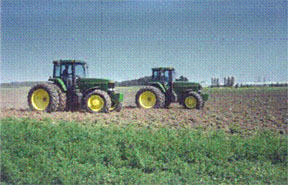Updated from an original article written by Michael Staton and Tim Harrigan of Michigan State University Extension
With diesel fuel prices hovering above $5 per gallon and weather-related planting delays, producers are looking for ways to improve tractor performance and fuel efficiency. One of the best ways to accomplish this is to inflate radial tires to the lowest recommended pressure for the load they carry before performing field work.

Tire inflation demonstration at MSU’s Ag Expo. Photo by Tim Harrigan, MSU Extension
A survey conducted in Oklahoma found that only 45% of the tractor tires were within the recommended tire inflation ranges. The benefits of proper tire inflation are clearly depicted in Photo 1. This photograph was taken during a field demonstration at Michigan State University’s Ag Expo where identical tractors were hitched with a cable and pulley system to a third tractor pulling a high-draft tillage tool. The front tractor with properly inflated tires consistently performed better than the trailing tractor with slightly over inflated tires. The tractor with the properly inflated tires will consume less fuel and perform field operations in less time. Continue reading Proper tractor tire pressure saves fuel and time


